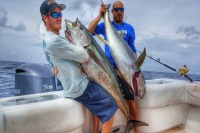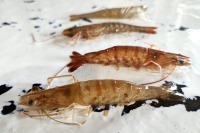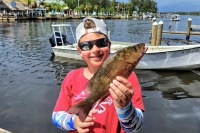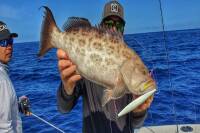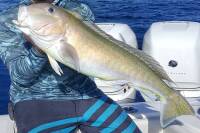Permit fish are a unique, oval-shaped gamefish with a yellowish-brown back, fins, and eyes. They can grow up to 50 inches in length and weigh up to 35 pounds. They are highly sought after for their size, strength, and fighting ability. Permit fish are commonly found in shallow waters, coral reefs, mangroves, estuaries, and lagoons. Techniques for targeting permit include flats fishing, fly fishing, and popping cork fishing.
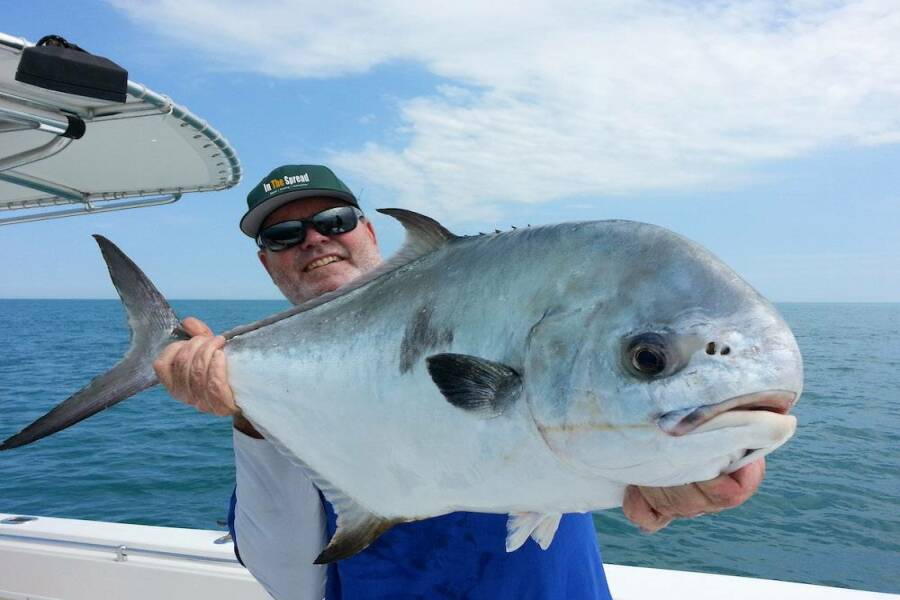
Permit Fishing – Know The Species
Permit are recognized by their unique, oval shape and its olive or gray colored back. It has a silver-white underside and a yellowish-brown back. Its fins are yellowish-brown and its eyes are golden. It has a long, continuous lateral line and a moderately long, deep body.
This unique fish can grow to a maximum size of around 50 inches in length and up to 35 pounds in weight. The largest permit fish are typically caught in the Caribbean and the Gulf of Mexico. The fish is a highly sought after gamefish due to its size, strength and impressive fighting ability. It is commonly found in shallow waters, around coral reefs and mangroves, and in estuaries and lagoons. It feeds on small crustaceans, mollusks and small fish.
Bonus Video: Permit Fish - Light Tackle for Giants
Capt. Scott Fawcett offers expert strategies and methods for landing monster fish. RJ Boyle, an inshore angler, shows off how to use light tackle to tangle with a large permit. Fawcett divulges information on baits, rigging, casting, boat handling, stalking tactics, equipment, and moving schools. View Short Trailer Below or Learn More Here
Permit Fishing
Permit are known for their impressive fighting ability and can put up quite a fight when hooked. They are strong and powerful and will often make long runs and put up a good fight. They are known for their acrobatic jumps, which can sometimes reach heights of up to four feet.
As a highly sought-after game fish, a variety of fishing techniques have been developed to target permit. Some of the more productive methods include:
- Flats fishing: Permit are often found in shallow water environments such as sandy or grassy flats. Anglers can use spinning or baitcasting gear with small crabs or shrimp as bait to target permit in these habitats.
- Fly fishing: Fly fishing is a popular method for targeting permit and can be highly effective, especially in shallow water environments. Anglers use a variety of crab and shrimp imitations to imitate the prey items that permit feed on.
- Popping cork fishing: Popping cork fishing involves using a cork that is bounced or "popped" along the surface of the water to mimic the movement of a fleeing baitfish. This technique can be highly effective in attracting permit and can be done with both bait and lures.
When matched with light tackle, permit can provide a strong and challenging fight for anglers. They are known for their powerful runs and acrobatic leaps, and they often make several long, hard runs in an attempt to shake the hook. The fight can last anywhere from several minutes to over an hour, making the permit a true test of an angler's skills and endurance.
Taxonomy and Ecology
The permit (Trachinotus falcatus) is a species of fish that is widely distributed throughout the tropical and subtropical waters of the Atlantic Ocean. The range of the permit spans from the coast of Florida and the Gulf of Mexico, throughout the Caribbean, and down to northern South America.
In terms of habitat, permit prefer shallow, sandy or grassy flats and are commonly found in the vicinity of coral reefs, mangrove lagoons, and seagrass beds. They are often observed swimming in large schools, feeding on crustaceans, mollusks, and small fish.
The permit (Trachinotus falcatus) is a species of fish that belongs to the family Carangidae, which is a group of predatory fishes that are found in marine and freshwater habitats throughout the world. In terms of taxonomy, the permit is classified as follows:
- Kingdom: Animalia
- Phylum: Chordata
- Class: Actinopterygii
- Order: Perciformes
- Family: Carangidae
- Genus: Trachinotus
- Species: T. falcatus
In terms of ecology, the permit is a habitat generalist, capable of inhabiting a variety of shallow marine environments including sandy or grassy flats, coral reefs, mangrove lagoons, and seagrass beds. They are opportunistic feeders and feed on a variety of prey including crustaceans, mollusks, and small fish.
Permit play an important role in the marine food web, serving as both predators and prey for a variety of species. For example, they are an important food source for larger predatory fish and birds, and their predatory behavior helps to control the populations of smaller fish and crustaceans.
Permit are highly adaptable and are capable of tolerating a wide range of salinity and water temperatures, making them a common target for both commercial and recreational fishing. Despite their wide distribution and adaptability, populations of permit have been declining in some areas due to overfishing and habitat destruction.
As a result, many organizations are working to conserve and protect the permit and their habitats, including the implementation of fishing regulations and supporting research on the life history and ecology of this species.
Migration Patterns of Permit
Permit are known to undertake migrations, although the specifics of their migration patterns can vary depending on the location and population. In general, permit are believed to migrate in response to changes in environmental conditions such as water temperature, food availability, and seasonal changes.
For example, permit populations in Florida and the Gulf of Mexico are known to undertake seasonal migrations in response to changes in water temperature. In the winter months, permit move from shallow water environments to deeper water where temperatures are more stable, and in the summer months, they move back to shallower waters to take advantage of increased food availability.
Similarly, in other parts of their range, such as the Caribbean, permit are believed to undertake migrations in response to changes in water temperature and the availability of food. In these areas, permit may move between inshore and offshore habitats, or between different regions of a reef system, in search of optimal conditions.
It is important to note that the specifics of permit migration patterns can vary greatly between populations and locations, and further research is needed to fully understand the migratory behaviors of this species. Nevertheless, understanding the migration patterns of permit can be important for conservation and management efforts, as well as for improving fishing success.

Predatory Behavior and Characteristics
Permit are predatory fish that are known for their feeding habits and distinctive behavior. Some of the key characteristics and behaviors that define the predatory nature of the permit include:
- Diet: Permit feed on a variety of prey items, including crustaceans, mollusks, and small fish. They are opportunistic feeders and have been observed feeding on a variety of prey items, depending on the availability of food in their environment.
- Feeding behavior: Permit are known for their surface-feeding behavior, in which they use their sharp, powerful jaws to bite or strike at prey items on the surface of the water. This behavior is especially noticeable when permit are feeding on schools of baitfish, as they will often leap out of the water to attack their prey.
- Ambush behavior: Permit are also known for their ambush behavior, in which they use their keen eyesight to locate prey and then position themselves in a way that allows them to strike quickly and effectively. This behavior is especially effective when permit are hunting in shallow water environments, where their prey may be more vulnerable.
- Speed and agility: Permit are capable of swimming at high speeds and are known for their agility and ability to make sudden, powerful runs. This makes them a challenging target for anglers and allows them to evade predators and escape danger effectively.
Overall, the predatory behavior and characteristics of the permit make them an important species in the marine food web, helping to control the populations of smaller fish and crustaceans. Their ability to adapt to a variety of habitats and feed on a wide range of prey also makes them a highly successful species, and a valuable target for both commercial and recreational fishing.
Artificial Lures for Permit
Artificial lures that work well for permit fishing can vary depending on a number of factors, including the time of year, water conditions, and the location being fished. However, there are some general guidelines that anglers often use when selecting lures for permit fishing:
- Type of lures: When fishing for permit, anglers often use lures that mimic the appearance and behavior of crustaceans, the primary food source for permit. Examples of such lures include crab and shrimp imitations, as well as small jigs or streamers that mimic small baitfish.
- Size of lures: The size of lures used for permit fishing can vary depending on the size of the permit being targeted, but generally, smaller lures in the 1/0 to 4/0 size range are used. This size range allows the angler to present the lure in a natural, realistic manner, and it is often effective in enticing strikes from permit.
- Color of lures: The color of lures used for permit fishing can vary depending on the water conditions, but natural colors such as tan, olive, and brown are often effective. In murky water, brighter colors such as chartreuse or yellow can be used to increase visibility.
The use of lures for permit fishing can differ in various parts of the Atlantic Ocean due to variations in the types of prey items available, as well as differences in the behavior and habits of permit populations in different regions. For example, permit populations in the Florida Keys and the Gulf of Mexico may be more susceptible to lures that mimic crabs and shrimp, while populations in other parts of the Atlantic Ocean may be more susceptible to lures that mimic small baitfish.
It is important to note that while these guidelines can be helpful, the most effective lures for permit fishing will vary depending on the individual fishing situation and the preferences of the angler. Therefore, it is often best to experiment with a variety of lures to determine what works best in any given situation.
Baits for Permit: Live and Dead
When using bait for permit fishing, the type and size of bait that works well can vary depending on a number of factors, including the time of year, water conditions, and the location being fished. However, there are some general guidelines that angler's often use when selecting bait for permit fishing:
- Type of bait: Common bait used for permit fishing include live or dead crabs, live or dead shrimp, and live or dead mullet.
- Size of bait: The size of bait used for permit fishing can vary depending on the size of the permit being targeted, but generally, smaller bait in the 3- to 4-inch range is used. This size range allows the angler to present the bait in a natural, realistic manner, and it is often effective in enticing strikes from permit.
- Live vs dead bait: Both live and dead bait can be effective for permit fishing, but the use of live bait may increase the chances of a strike, as the scent and movement of live bait can attract the fish. On the other hand, dead bait can be easier to handle and store and can still be effective if presented properly.
The range of bait preferences in different parts of the Atlantic Ocean can vary depending on the types of prey items that are available in those areas. For example, in some areas, permit may have a preference for crustaceans such as crabs or shrimp, while in other areas, they may be more susceptible to baitfish such as mullet.
It is important to note that while these guidelines can be helpful, the most effective bait for permit fishing will vary depending on the individual fishing situation and the preferences of the angler. Therefore, it is often best to experiment with a variety of baits to determine what works best in any given situation.
Hooks for Permit Fishing with Bait
When using bait to catch permit, the type and size of hooks used can have a significant impact on the success of the fishing trip. Here are some general guidelines for selecting hooks when fishing for permit with bait:
- Hook size: The size of hooks used for permit fishing can vary depending on the size of the bait being used, but generally, hooks in the 2/0 to 4/0 size range are used. This size range provides the appropriate strength and holding power for larger permit, while still being small enough to allow for a natural presentation of the bait.
- Hook type: The type of hook used for permit fishing can vary depending on the type of bait being used. Here are some common hooks used for different baits:
- Crabs: A wide gap hook in the 2/0 to 4/0 size range is often used when fishing with crabs. A circle hook may also be used, as it reduces the chances of gut-hooking the fish and allows for a more natural presentation of the crab.
- Shrimp: A wide gap hook in the 2/0 to 4/0 size range is often used when fishing with shrimp. A circle hook is also a good option, as it helps keep the shrimp in place and reduces the chances of the bait sliding off the hook.
- Mullet: A 2/0 to 4/0 J-hook is often used when fishing with mullet. A J-hook allows for a more secure hold on the bait and makes it easier to cast and retrieve the bait.
These are general guidelines, and the best hook type and size will depend on the individual fishing situation and the preferences of the angler. Experimenting with different hooks can help determine the most effective option for any given situation.
It is important to note that the use of appropriate hooks is critical for responsible and ethical fishing practices, as well as for the health and well-being of the fish being caught. Anglers should always follow fishing regulations and guidelines, and use hooks that are appropriate for the size and species of fish being targeted.
To learn more about permit fishing, check out our Permit Fishing Videos.
Sarah Mendez Especialista de Pesca, In The Spread
User Reviews







